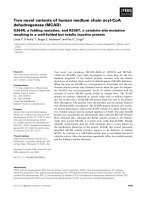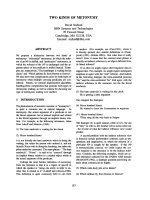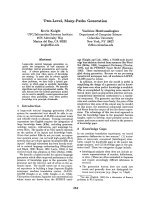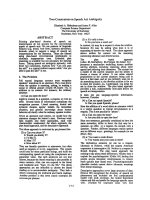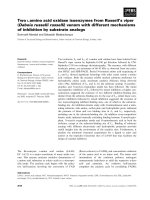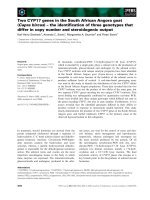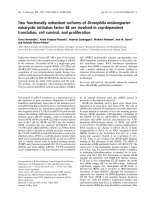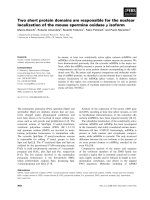Báo cáo khoa học: "Two Languages Are More Informative Than One *" potx
Bạn đang xem bản rút gọn của tài liệu. Xem và tải ngay bản đầy đủ của tài liệu tại đây (729.37 KB, 8 trang )
Two Languages Are More Informative Than One *
Ido Dagan
Computer Science Department
Technion, Haifa, Israel
and
IBM Scientific Center
Haifa, Israel
Alon Itai
Computer Science Department
Technion, Haifa, Israel
itai~cs.technion.ac.il
Ulrike Schwall
IBM Scientific Center
Institute for Knowledge
Based Systems
Heidelberg, Germany
schwall@dhdibml
Abstract
This paper presents a new approach for resolving lex-
ical ambiguities in one language using statistical data
on lexical relations in another language. This ap-
proach exploits the differences between mappings of
words to senses in different languages. We concen-
trate on the problem of target word selection in ma-
chine translation, for which the approach is directly
applicable, and employ a statistical model for the se-
lection mechanism. The model was evaluated using
two sets of Hebrew and German examples and was
found to be very useful for disambiguation.
1 Introduction
The resolution of hxical ambiguities in non-restricted
text is one of the most difficult tasks of natural lan-
guage processing. A related task in machine trans-
lation is target word selection - the task of deciding
which target language word is the most appropriate
equivalent of a source language word in context. In
addition to the alternatives introduced from the dif-
ferent word senses of the source language word, the
target language may specify additional alternatives
that differ mainly in their usages.
Traditionally various linguistic levels were used
to deal with this problem: syntactic, semantic and
pragmatic. Computationally the syntactic methods
are the easiest, but are of no avail in the frequent
situation when the different senses of the word show
*This research was partially supported by grant number
120-741 of
the
Iarael Council for Research and
Development
the same syntactic behavior, having the same part of
speech and even the same subcategorization frame.
Substantial application of semantic or pragmatic
knowledge about the word and its context for broad
domains requires compiling huge amounts of knowl-
edge, whose usefulness for practical applications has
not yet been proven (Lenat et al., 1990; Nirenburg et
al., 1988; Chodorow et al., 1985). Moreover, such
methods fail to reflect word usages.
It is known for many years that the use of a word in
the language provides information about its meaning
(Wittgenstein, 1953). Also, statistical approaches
which were popular few decades ago have recently
reawakened and were found useful for computational
linguistics. Consequently, a possible (though partial)
alternative to using manually constructed knowledge
can be found in the use of statistical data on the oc-
currence of lexical relations in large corpora. The
use of such relations (mainly relations between verbs
or nouns and their arguments and modifiers) for var-
ious purposes has received growing attention in re-
cent research (Church and Hanks, 1990; Zernik and
Jacobs, 1990; Hindle, 1990). More specifically, two
recent works have suggested to use statistical data
on lexical relations for resolving ambiguity cases of
PP-attachment (Hindle and Rooth, 1990) and pro-
noun references (Dagan and Itai, 1990a; Dagan and
Itai, 1990b).
Clearly, statistical methods can be useful also for
target word selection. Consider, for example, the
Hebrew sentence extracted from the foreign news
section of the daily Haaretz, September 1990 (tran-
scripted to Latin letters).
130
(1) Nose ze maria' mi-shtei ha-mdinot mi-lahtom 'al
hoze shalom.
This sentence would translate into English as:
(2) That issue prevented the two countries from
signing a peace treaty.
The verb 'lab_tom' has four word senses: 'sign',
'seal', 'finish' and 'close'. Whereas the noun 'hose'
means both 'contract' and 'treaty'. Here the differ-
ence is not in the meaning, but in usage.
One possible solution is to consult a Hebrew corpus
tagged with word senses, from which we would prob-
ably learn that the sense 'sign' of 'lahtom' appears
more frequently with 'hoze' as its object than all the
other senses. Thus we should prefer that sense. How-
ever, the size of corpora required to identify lexical
relations in a broad domain is huge (tens of millions
of words) and therefore it is usually not feasible to
have such corpora manually tagged with word senses.
The problem of choosing between 'treaty' and 'con-
tract' cannot be solved using only information on He-
brew, because Hebrew does not distinguish between
them.
The solution suggested in this paper is to iden-
tify the lexical relationships in corpora of the target
language, instead of the source language. Consult-
ing English corpora of 150 million words, yields the
following statistics on single word frequencies: 'sign'
appeared 28674 times, 'seal'
2771
times, 'finish' ap-
peared 15595 times, 'close' 38291 times, 'treaty' 7331
times and 'contract' 30757 times. Using a naive ap-
proach of choosing the most frequent word yields
(3) *That issue prevented the two countries from
closing a peace contract.
This may be improved upon if we use lexical rela-
tions. We consider word combinations and count how
often they appeared in the same syntactic relation
as in the ambiguous sentence. For the above exam-
ple, among the successfully parsed sentences of the
corpus, the noun compound 'peace treaty' appeared
49 times, whereas the compound 'peace contract' did
not appear at all; 'to sign a treaty' appeared 79 times
while none of the other three alternatives appeared
more than twice. Thus we first prefer 'treaty' to 'con-
tract' because of the noun compound 'peace treaty'
and then proceed to prefer 'sign' since it appears
most frequently having the object 'treaty' (the or-
der of selection is explained in section 3). Thus in
this case our method yielded the correct translation.
Using this method, we take the point of view that
some ambiguity problems are easier to solve at the
level of the target language instead of the source
language. The source language sentences are con-
sidered as a noisy source for target language sen-
tences, and our task is to devise a target language
model that prefers the most reasonable translation.
Machine translation (MT) is thus viewed in part
as a recognition problem, and the statistical model
we use specifically for target word selection may be
compared with other language models in recognition
tasks (e.g. Katz (1985) for speech recognition).
In contrast to this view, previous approaches in MT
typically resolved examples like (1) by stating various
constraints in terms of the source language (Niren-
burg, 1987). As explained before, such constraints
cannot be acquired automatically and therefore are
usually limited in their coverage.
The experiment conducted to test the statistical
model clearly shows that the statistics on lexical re-
lations are very useful for disambiguation. Most no-
table is the result for the set of examples for Hebrew
to English translation, which was picked randomly
from foreign news sections in Israeli press. For this
set, the statistical model was applicable for 70% of
the ambiguous words, and its selection was then cor-
rect for 92% of the cases.
These results for target word selection in machine
translation suggest to use a similar mechanism even
if we are interested only in word sense disambigua-
tion within a single language! In order to select the
right sense of a word, in a broad coverage applica-
tion, it is useful to identify lexical relations between
word senses. However, within corpora of a single lan-
guage it is possible to identify automatically only re-
lations at the word level, which are of course not use-
ful for selecting word senses in that language. This
is where other languages can supply the solution, ex-
ploiting the fact that the mapping between words
and word senses varies significantly among different
languages. For instance, the English words 'sign' and
'seal' correspond to a very large extent to two distinct
senses of the Hebrew word 'lab_tom' (from example
(1)). These senses should be distinguished by most
applications of Hebrew understanding programs. To
make this distinction, it is possible to do the same
process that is performed for target word selection,
by producing all the English alternatives for the lex-
ical relations involving 'lahtom'. Then the Hebrew
sense which corresponds to the most plausible En-
glish lexical relations is preferred. This process re-
quires a bilingual lexicon which maps each Hebrew
sense separately into its possible translations, similar
131
to a Hebrew-Hebrew-English lexicon (like the Oxford
English-English-Hebrew dictionary (Hornby et al.,
1980)).
In some cases, different senses of a Hebrew word
map to the same word also in English. In these cases,
the lexical relations of each sense cannot be identi-
fied in an English corpus, and a third language is
required to distinguish among these senses. As a
long term vision, one can imagine a multilingual cor-
pora based system, which exploits the differences be-
tween languages to automatically acquire knowledge
about word senses. As explained above, this knowl-
edge would be crucial for lexical disambiguation, and
will also help to refine other types of knowledge ac-
quired from large corpora 1 .
2 The Linguistic Model
The ambiguity of a word is determined by the num-
ber of distinct, non-equivalent representations into
which the word can be mapped (Van Eynde et al.,
1982). In the case of machine translation the ambi-
guity of a source word is thus given by the number
of target representations for that word in the bilin-
gual lexicon of the translation system. Given a spe-
cific syntactic context the ambiguity can be reduced
to the number of alternatives which may appear in
that context. For instance, if a certain translation
of a verb corresponds to an intransitive occurrence
of that verb, then this possibility is eliminated when
the verb occurs with a direct object. In this work
we are interested only in those ambiguities that are
left after applying all the deterministic syntactic con-
straints.
For example, consider the following Hebrew sen-
tence, taken from the daily Haaretz, September 1990:
(4) Diplomatim svurim ki hitztarrfuto shell Hon
Sun magdila et ha.sikkuyim l-hassagat hitqad-
dmut ba-sihot.
Here, the ambiguous words in translation to En-
glish are 'magdila', 'hitqaddmut' and 'sih_ot'. To fa-
cilitate the reading, we give the translation of the
sentence to English, and in each case of an ambiguous
selection all the alternatives are listed within curly
brackets, the first alternative being the correct one.
1For inatanoe, Hindie (1990) indicates the need to dis-
tlnguhsh among aeaases of polysemic words for his statistical
c]~Hic~tlon method.
132
(5) Diplomats believe that the joining of Hon
Sun { increases I enlarges I magnifies } the
chances for achieving { progress [ advance I
advancement } in the { talks I conversations I
calls }.
We use the term a lezical relation to denote the
cooccurrence relation of two (or possibly more) spe-
cific words in a sentence, having a certain syntac-
tic relationship between them. Typical relations are
between verbs and their subjects, objects, comple-
ments, adverbs and modifying prepositional phrases.
Similarly, nouns are related also with their objects,
with their modifying nouns in compounds and with
their modifying adjectives and prepositional phrases.
The relational representation of a sentence is sim-
ply the list of all lexical relations that occur in the
sentence. For our purpose, the relational represen-
tation contains only those relations that involve at
least one ambiguous word. The relational represen-
tation for example (4) is given in (6) (for readability
we represent the Hebrew word by its English equiv-
alent, prefixed by 'H' to denote the fact that it is a
Hebrew word):
(6) a. (subj-verb: H-joining H-increase)
b. (verb-obj: H-increase H-chance)
c. (verb-obj: H-achieve H-progress)
d. (noun-pp: H-progress H-in H-talks)
The relational representation of a source sentence
is reflected also in its translation to a target sen-
tence. In some cases the relational representation of
the target sentence is completely equivalent to that
of the source sentence, and can be achieved just by
substituting the source words with target words. In
other cases, the mapping between source and target
relations is more complicated, as is the case for the
following German example:
(7) Der Tisch gefaellt mir. I like the table.
Here, the original subject of the source sentence
becomes the object in the target sentence. This kind
of mapping usually influences the translation process
and is therefore encoded in components of the trans-
lation program, either explicitly or implicitly, espe-
cially in transfer based systems. Our model assumes
that such a mapping of source language relations to
target language relations is possible, an assumption
that is valid for many practical cases.
When applying the mapping of relations on one
lexicai relation of the source sentence we get several
alternatives for a target relation. For instance, ap-
plying the mapping to example (6-c) we get three
alternatives for the relation in the target sentence:
(8) (verb-obj: achieve progress)
(verb-obj: achieve advance)
(verb-obj: achieve advancement)
For example (6-d) we get 9 alternatives, since
both 'H-progress' and 'H-talks' have three alterna-
tive translations.
In order to decide which alternative is the most
probable, we count the frequencies of all the alter-
native target relations in very large corpora. For ex-
ample (8) we got the counts 20, 5 and 1 respectively.
Similarly, the target relation 'to increase chance' was
counted 20 times, while the other alternatives were
not observed at all. These counts are given as input
to the statistical model described in the next section,
which performs the actual target word selection.
3 The Statistical Model
Our selection algorithm is based on the following sta-
tistical model. Consider first a single relation. The
linguistic model provides us with several alternatives
as in example (8). We assume that each alternative
has a theoretical probability
Pi
to be appropriate for
this case. We wish to select the alternative for which
Pi is maximal, provided that it is significantly larger
than the others.
We have decided to measure this significance by
the odds ratio of the two most probable alternatives
P = Pl/P2.
However, we do not know the theoretical
probabilities, therefore we get a bound for p using
the frequencies of the alternatives in the corpus.
Let/3 i be the probabilities as observed in the cor-
pus (101 =
ni/n,
where
ni
is the number of times that
alternative i appeared in the corpus and n is the to-
tal number of times that all the alternatives for the
relation appeared in the corpus).
For mathematical convenience we bound In p in-
stead of p. Assuming that samples of the alternative
relations are distributed normally, we get the follow-
ing bound with confidence 1 - a:
where Z is the eonfidenee coefficient. We approxi-
mate the variance by the delta method (e.g. John-
son and Wichern (1982)):
=
,n
_ 1 p~(1 - p~) -) 1 p~(1 - p~) + 2 P*P~
p~ n p~ n npxI~
1 1 1 1 1 1
= + ~, + =~+~.
npa nI~ n~x n~ nl n2
Therefore we get that with probability at least
1 or,
In _> In - Zl-a +
We denote the right hand side (the bound) by
B~,(nl, n2).
In sentences with several relations, we consider the
best two alternatives for each relation, and take the
relation for which B,, is largest. If this Ba is less than
a specified threshold then we do not choose between
the alternatives. Otherwise, we choose the most fre-
quent alternative to this relation and select the tar-
get words appearing in this alternative. We then
eliminate all the other alternative translations for the
selected words, and accordingly eliminate all the al-
ternatives for the remaining relations which involve
these translations. In addition we update the ob-
served probabilities for the remaining relations, and
consequently the remaining Ba's. This procedure is
repeated until all target words have been determined
or the maximal Ba is below the threshold.
The actual parameters we have used so far were
c~ = 0.05 and the bound for Bawas -0.5.
To illustrate the selection algorithm, we give the
details for example (6). The highest bound for the
odds ratio (Ba = 1.36) was received for the relation
'increase-chance', thus selecting the translation 'in-
crease' for 'H-increase'. The second was Ba = 0.96,
133
for 'achieve-progress'. This selected the transla-
tions 'achieve' and 'progress', while eliminating the
other senses of 'H-progress' in the remaining rela-
tions. Then, for the relation 'progress-in-talks' we
got Ba = 0.3, thus selecting the appropriate transla-
tion for 'H-talks'.
4 The Experiment
An experiment was conducted to test the perfor-
mance of the statistical model in translation from
Hebrew and German to English. Two sets of para-
graphs were extracted randomly from current He-
brew and German press. The Hebrew set con-
tained 10 paragraphs taken from foreign news sec-
tions, while the German set contained 12 paragraphs
of text not restricted to a specific topic.
Within these paragraphs we have (manually) iden-
tified the target word selection ambiguities, using a
bilingual dictionary. Some of the alternative transla-
tions in the dictionary were omitted if it was judged
that they will not be considered by an actual compo-
nent of a machine translation program. These cases
included very rare or archaic translations (that would
not be contained in an MT lexicon) and alternatives
that could be eliminated using syntactic knowledge
(as explained in section 2) 2 . For each of the remain-
ing alternatives, it was judged if it can serve as an
acceptable translation in the given context. This a
priori judgment was used later to decide whether the
selection of the automatic procedure is correct. As a
result of this process, the Hebrew set contained 105
ambiguous words (which had at least one unaccept-
able translation) and the German set 54 ambiguous
words.
Now it was necessary to identify the lexical rela-
tions within each of the sentences. As explained be-
fore, this should be done using a source language
parser, and then mapping the source relations to
the target relations. At this stage of the research,
we still do not have the necessary resources to per-
form the entire process automatically s, therefore we
have approximated it by translating the sentences
into English and extracting the lexical relations us-
ing the English Slot Grammar (ESG) parser (mc-
2Due to some technicalities,
we
have also restricted
the
experiment to cases in which all the relevant translations of
a word consists exactly one English word, which is the
most
frequent situaticm.
awe
are currently integrating this process within GSG
(German Slot
Gr~nmm')
and LMT-GE (the Germs~a
to
En-
glish MT prototype).
Cord, 1989) 4. Using this parser we have classified
the lexical relations to rather general classes of syn-
tactic relations, based on the slot structure of ESG.
The important syntactic relations used were between
a verb and its arguments and modifiers (counting as
one class all objects, indirect objects, complements
and nouns in modifying prepositional phrases) and
between a noun and its arguments and modifiers
(counting as one class all noun objects, modifying
nouns in compounds and nouns in modifying prepo-
sitional phrases). The success of using this general
level of syntactic relations indicates that even a rough
mapping of source to target language relations would
be useful for the statistical model.
The statistics for the alternative English relations
in each sentence were extracted from three cor-
pora: The Washington Post articles (about 40 mil-
lion words), Associated Press news wire (24 million)
and the Hansard corpus of the proceedings of the
Canadian Parliament (85 million words). The statis-
tics were extracted only from sentences of up to 25
words (to facilitate parsing) which contained alto-
gether about 55 million words. The lexical relations
in the corpora were extracted by ESG, in the same
way they were extracted for the English version of the
example sentences (see Dagan and Itai (1990a) for a
discussion on using an automatic parser for extract-
ing lexical relations from a corpus, and for the tech-
nique of acquiring the statistics). The parser failed
to produce any parse for about 35% of the sentences,
which further reduced the actual size of the corpora
which was used.
5 Evaluation
Two measurements,
applicability and precision, are
used to evaluate the performance of the statistical
model. The applicability denotes the proportion of
cases for which the model performed a selection, i.e.
those cases for which the bound Bapassed the thresh-
old. The precision denotes the proportion of cases for
which the model performed a correct selection out of
all the applicable cases.
We compare the precision of the model to that
of the "word frequencies" procedure, which always
selects the most frequent target word. This naive
"straw-man" is less sophisticated than other meth-
ods suggested in the literature but it is useful as a
common benchmark (e.g. Sadler (1989)) since it can
4The parsing process was controlled manually to make sure
that we do not get wrong relational representation of
the exo
amp]es due to parsing errors.
134
be easily implemented. The success rate of the "word
frequencies" procedure can serve as a measure for the
degree of lexical ambiguity in a given set of examples,
and thus different methods can be partly compared
by their degree of success relative to this procedure.
Out of the 105 ambiguous Hebrew words, for 32
the bound Badid not pass the threshold (applicabil-
ity of 70%). The remaining 73 examples were dis-
tributed according to the following table:
[ Hebrew-Engiish ]] Word Frequencies
correct I incorrect I
Relations
Statistics [ correct
Thus the precision of the statistical model was 92%
(67/73) 5 while relying just on word frequencies yields
64% (47/73).
Out of the 54 ambiguous German words, for 22 the
bound Badid not pass the threshold (applicability of
59%). The remaining 32 examples were distributed
according to the following table:
Oerm English II Word equeoci I
,, correct ] incorrect
Relations
Statistics [ correct 8
in°°rre ' [[ I 0 I
Thus the precision of the statistical model was 75%
(24/32), while relying just on word frequencies yields
53% (18/32). We attribute the lower success rate for
the German examples to the fact that they were not
restricted to topics that are well represented in the
corpus.
Statistical analysis for the larger set of Hebrew ex-
amples shows that with 95% confidence our method
succeeds in at least 86% of the applicable examples
(using the parameters of the distribution of propor-
tions). With the same confidence, our method im-
proves the word frequency method by at least 18%
(using confidence interval for the difference of pro-
portions in multinomial distribution, where the four
cells of the multinomial correspond to the four entries
in the result table).
In the examples that were treated correctly by our
5An a posteriorl observation showed that in three of the
six errors the selection of the model was actually acceptable,
and the a priori judgment of the hnman translator was too se-
vere. For example, in one of these cases the statistics selected
the expression 'to begin talks' while the human translator re-
garded this expression as incorrect and selected 'to start talks'.
If we consider these cases as correct then there are only three
selection errors, getting a 96% precision.
method, such as the examples in the previous sec-
tions, the statistics succeeded to capture two major
types of disambiguating data. In preferring 'sign-
treaty' upon 'seal-treaty', the statistics reflect the
relevant semantic constraint. In preferring 'peace-
treaty' upon 'peace-contract', the statistics reflect
the hxical usage of 'treaty' in English which differs
from the usage of 'h_oze' in Hebrew.
6
Failures and Possible Im-
provements
A detailed analysis of the failures of the method is
most important, as it both suggests possible improve-
ments for the model and indicates its limitations.
As described above, these failures include either the
cases for which the method was not applicable (no
selection) or the cases in which it made an incorrect
selection. The following paragraphs list the various
reasons for both types.
6.1
Inapplicability
Insufficient data. This was the reason for nearly
all the cases of inapplicability. For instance, none of
the alternative relations 'an investigator of corrup-
tion' (the correct one) or 'researcher of corruption'
(the incorrect one) was observed in the parsed cor-
pus. In this case it is possible to perform the correct
selection if we used only statistics about the cooc-
currences of 'corruption' with either 'investigator' or
'researcher', without looking for any syntactic rela-
tion (as in Church and Hanks (1990)). The use of
this statistic is a subject for further research, but our
initial data suggests that it can substantially increase
the applicability of the statistical method with just
a little decrease in its precision.
Another way to deal with the lack of statistical
data for the specific words in question is to use
statistics about similar words. This is the basis for
Sadler's Analogical Semantics (1989) which has not
yet proved effective. His results may be improved if
more sophisticated techniques and larger corpora are
used to establish similarity between words (such as
in (Hindle, 1990)).
Conflicting data. In very few cases two alterna-
tives were supported equally by the statistical data,
thus preventing a selection. In such cases, both alter-
natives are valid at the independent level of the lexi-
cal relation, but may be inappropriate for the specific
context. For instance, the two alternatives of 'to take
135
a job' or 'to take a position' appeared in one of the
examples, but since the general context concerned
with the position of a prime minister only the latter
was appropriate. In order to resolve such examples
it may be useful to consider also cooccurrences of
the ambiguous word with other words in the broader
context. For instance, the word 'minister' seems to
cooccur in the same context more frequently with
'position' than with 'job'.
In another example both alternatives were appro-
priate also for the specific context. This happened
with the German verb 'werfen', which may be trans-
lated (among other options) as 'throw', 'cast' or
'score'. In our example 'werfen' appeared in the con-
text of 'to throw/cast light' and these two correct al-
ternatives had equal frequencies in the corpus ('score'
was successfully eliminated). In such situations any
selection between the alternatives will be appropriate
and therefore any algorithm that handles conflicting
data will work properly.
6.2 Incorrect Selection
Using the inappropriate relation. One of the ex-
amples contained the Hebrew word 'matzav', which
two of its possible translations are 'state' and 'po-
sition'. The phrase which contained this word was:
'to put an end to the {state I position} of war '.
The ambiguous word is involved in two syntactic rela-
tions, being a complement of 'put' and also modified
by 'war'. The corresponding frequencies were:
(9) verb-comp: put-position 320
verb-comp: put-state 18
noun-nob j: state-war 13
noun-nob j: position-war 2
The bound of the odds ration (Ba) for the first re-
lation was higher than for the second, and therefore
this relation determined the translation as 'position'.
However, the correct translation should be 'state', as
determined by the second relation.
This example suggests that while ordering the in-
volved relations (or using any other weighting mech-
anism) it may be necessary to give different weights
to the different types of syntactic relations. For in-
stance, it seems reasonable that the object of a noun
should receive greater weight in selecting the noun's
sense than the verb for which this noun serves as a
complement.
Confusing senses. In another example, the
Hebrew word 'qatann', which two of its meanings
are 'small' and 'young', modified the word 'sikkuy',
which means 'prospect' or 'chance'. In this context,
the correct sense is necessarily 'small'. However, the
relation that was observed in the corpus was 'young
prospect', relating to the human sense of 'prospect'
which appeared in sport articles (a promising young
person). This borrowed sense of 'prospect' is nec-
essarily inappropriate, since in Hebrew it is repre-
sented by the equivalent of 'hope' ('tiqva'), and not
by 'sikkuy'.
The reason for this problem is that after producing
the possible target alternatives, our model ignores
the source language input as it uses only a mono-
lingual target corpus. This can be solved if we use
an aligned bilingual corpus, as suggested by Sadler
(1989) and Brown et al. (1990). In such a cor-
pus the occurrences of the relation 'young prospect'
will be aligned to the corresponding occurrences of
the Hebrew word 'tiqva', and will not be used when
the Hebrew word 'sikkuy' is involved. Yet, it should
be brought in mind that an aligned corpus is the re-
sult of manual translation, which can be viewed as
a manual tagging of the words with their equivalent
senses in the other language. This resource is much
more expensive and less available than the untagged
monolingual corpus, while it seems to be necessary
only for relatively rare situations.
Lack of deep understanding. By their nature,
statistical methods rely on large quantities of shallow
information. Thus, they are doomed to fail when dis-
ambiguation can rely only on deep understanding of
the text and no other surface cues are available. This
happened in one of the Hebrew examples, where the
two alternatives were either 'emigration law' or 'im-
migration law' (the Hebrew word 'hagira' is used for
both subsenses). While the context indicated that
the first alternative is correct, the statistics preferred
the second alternative. It seems that such cases are
quiet rare, but only further evaluation will show the
extent to which deep understanding is really needed.
7 Conclusions
The method presented takes advantage of two lin-
guistic phenomena: the different usage of words and
word senses among
different
languages and the im-
portance of lexical cooccurrences within syntactic re-
lations. The experiment shows that these phenom-
ena are indeed useful for practical disambiguation.
We suggest that the high precision received in the
experiment relies on two characteristics of the am-
136
biguity phenomena, namely the sparseness and re-
dundancy of the disambiguating data. By sparseness
we mean that within the large space of alternative
interpretations produced by ambiguous utterances,
only a small portion is commonly used. Therefore
the chance of an inappropriate interpretation to be
observed in the corpus (in other contexts) is low.
Redundancy relates to the fact that different infor-
mants (such as different lexical relations or deep un-
derstanding) tend to support rather than contradict
one another, and therefore the chance of picking a
"wrong" informant is low.
The examination of the failures suggests that fu-
ture research may improve both the applicability and
precision of the model. Our next goal is to handle in-
applicable cases by using cooccurrence data regard-
less of syntactic relations and similarities between
words. We expect that increasing the applicability
will lead to some decrease in precision, similar to the
tradeoff between recall and precision in information
retrieval. Pursuing this tradeoff will improve the per-
formance of the method and reveal its limitations.
8 Acknowledgments
We would like to thank Mori Rimon, Peter Brown,
Ayala Cohen, Ulrike Rackow, Herb Leass and Hans
Karlgren for their help and comments.
References
[1] Brown, P., Cocks, J., Della Pietra, S., Della
Pietra, V., Jelinek, F., Mercer, R.L. and Rossin
P.S., A statistical approach to language transla-
tion, Computational Linguistics, vol. 16(2), 79-
85 (1990).
[2] Chodorow, M. S., R. J. Byrd and G. E. Heidron,
Extracting Semantic Hierarchies from a Large
On-Line Dictionary. Proc. of the 23rd Annual
Meeting of the ACL, 299-304 (1985).
[3] Church, K. W., and Hanks, P., Word associa-
tion norms, mutual information, and Lexicogra-
phy, Computational Linguistics, vol. 16(1), 22-
29 (1990).
[4] Dagan, I. and A. Itai, Automatic Acquisition
of Constraints for the Resolution of Anaphora
References and Syntactic Ambiguities, COLING
1990, Helsinki, Finland.
[5] Dagan, I. and A. Itai, A Statistical Filter for
Resolving Pronoun References, Proc. of the 7th
Israeli Sym. on Artificial Intelligence and Com-
puter Vision, 1990.
[6] Hindle, D. Noun Classification from Predicate-
Argument Structures, Proc. of the 28rd Annual
Meeting of the ACL, (1990).
[7] Hindle D. and M. Rooth, Structural Ambiguity
and Lexical Relations, Proc. of the Speech and
Natural Language Workshop, (DARPA), June
1990.
[8] Hornby, A. S., C. Ruse, J. A. Reif and Y.
Levy, Ozford Student's Dictionanary for He-
brew Speakers, Kernerman Publishing Ltd, Lon-
nie Kahn & Co. Ltd. (1986).
[9] Johnson, R. A. and D. W. Wichern, Multivariate
Statistical Analysis, Prentice-Hall, 1982.
[10] Katz, S., Recursive m-gram language model via
a smoothing of Turing's formula, IBM Tech. Dis-
closure Bull., 1985.
[11] Lenat, D. B., R. V. Guha, K. Pittman, D. Pratt
and M. Shepherd, Cyc: toward programs with
common sense, Comm. ACM, vol. 33(8), 1990.
[12] McCord, M. C., A new version of slot grammar,
Research Report RC 1~506, IBM Research Di-
vision, Yorktown Heights, NY, 1989.
[13] Sirenburg, S., (ed.), Machine Translation, Cam-
bridge University Press (1987).
[14] Nirenburg, S., I. Monarch, T. Kaufmann, I.
Nirenburg and J. Carbonell. Acquisition of
Very Large Knowledge Bases: Methodology,
Tools and Applications, Center for Machine
Translation, Carnegie-Mellon, CMU-CMT-88-
108, (1988).
[15] Sadler, V., Working with analogical semantics:
disambiguation techniques in DLT, Foris Publi-
cations, 1989.
[16] Van Eynde, F. et al.: The Task of Transfer vis-a-
vis Analysis and Generation. Eurotra Final Re-
port ET-10-B/NL, (1982).
[17] Wittgenstein, L. Philosophical Investigations,
Oxford (1953).
[18] Zernik U., and P. Jacobs, Tagging for Learn-
ing: Collecting Thematic Relations from Cor-
pus. Proc. COLING 1990.
137
